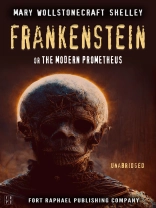On a miserable summer trip to Geneva with her future husband, Percy Bysshe Shelley, poet Lord Byron and a small group of friends, writer Mary Wollstonecraft was asked to participate in a game where the guests would create a ghost story and share it with the group. Everyone told their stories, but Mary’s creation surprised them all. She had conceived of the idea that would later become her best known work, a tale of horror and creation, the legendary early science fiction classic: Frankenstein, or the Modern Prometheus.
The story tells the tale of Doctor Victor Frankenstein who develops a method to impart life to dead matter. Attempting to build something beautiful, Frankenstein instead creates a hideous humanoid figure and flees his creation in terror. The Creature, now abandoned, roams the country under cover of darkness and develops a deep-seated resentment towards humanity and his own creator. The two beings – the scientist and the result of his experiment – find their destinies intertwined as each attempts to destroy the other.
A Gothic tale of creation and the very meaning of being alive, Frankenstein is among the most revered early science fiction works and, over the years, the story has been adapted into dozens of stage, screen and television productions.
Sobre o autor
Mary Wollstonecraft Shelley (1797-1851) was a British novelist, best known for creating the Gothic novel Frankenstein, or the Modern Prometheus. Her mother – the philosopher, writer and women’s rights advocate Mary Wollstonecraft – having died eleven days following her birth, Mary was raised by her father, the political philosopher William Godwin. Godwin instilled in young Mary a number of political views considered ‘radical’ for that era, including an affinity for anarchist politics. Mary would become romantically involved with one of her father’s political disciples, the Romantic poet Percy Bysshe Shelley. In 1816, the couple traveled to Geneva, where they spent a summer with their friend Claire Clairmont, Claire’s lover, the poet Lord Byron and a small party of friends. The summer proved to be wet and miserable and the group opted to play a game where they would make up ‘ghost stories’ to pass the time. Each of the revelers contributed, but Mary surprised them all with a fable of horror and creation, later developed into the early science fiction classic, Frankenstein.Mary also wrote the historical novels Valperga (1823) and Perkin Warbeck (1830), the apocalyptic novel The Last Man, as well as Lodore (1835) and Falkner (1837) as well as travel books, short stories and biographical articles. She was also a fierce advocate for and promoter of her husband’s work. The couple had four children, three of whom died very young. Mary herself succumbed to a brain tumor in 1851 and died at the age of 53. Frankenstein remains her best known work and the story has been adapted into dozens of stage, screen and television productions.












